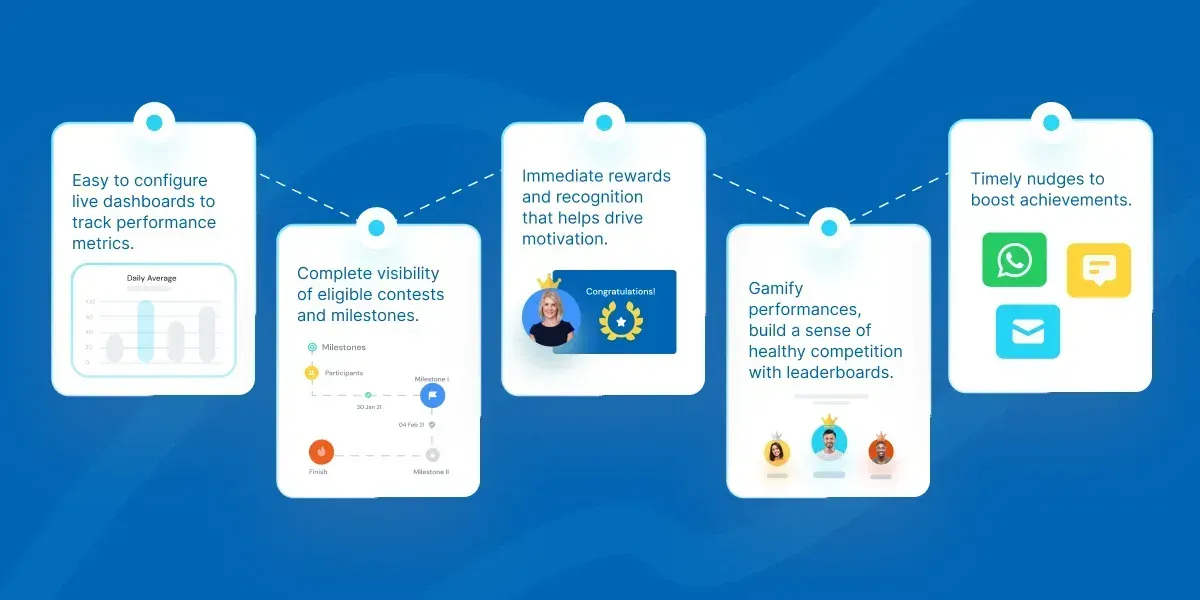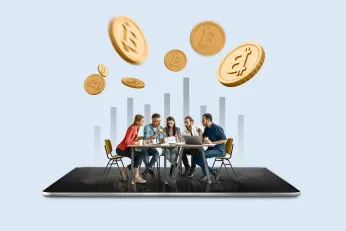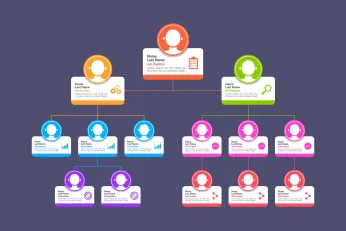Sales Gamification: A Strategic Approach to Boost Performance and Engagement
Learn how sales gamification transforms sales processes by boosting motivation, engagement, and productivity using game-based elements like points, rewards, and leaderboards.
On this page
Sales gamification is an innovative approach that integrates game mechanics into the sales process to motivate and engage sales teams. Apparently, According to a Salesforce blog post, 71% of surveyed companies using sales gamification tools report 11% to 50% increases in measured sales performance.
By transforming routine tasks into exciting challenges, sales gamification can significantly enhance productivity, foster a competitive yet collaborative environment, and ultimately drive sales performance.
This blog will explore the evolution, benefits, and best practices of implementing gamification in sales based on insights from historical developments and contemporary applications.
How did gamification come to be?
The concept of gamification has a rich history that dates back to 1978 when Richard Bartle, a renowned game designer and researcher, created MUD1 (Multi-User Dungeon). This text-based system was among the first to offer multiplayer experiences, allowing users to share an online reality. Over the years, the principles of gamification evolved, gradually permeating various industries.
The term "gamification" gained popularity in 2010, referring to the application of gaming principles and mechanics to non-game contexts. In 2011, the potential of gamification was highlighted at the first annual Gamification Summit. Predictions by Gartner indicated that by 2014, 70% of Global 2000 organizations would have at least one gamified application, though 80% of these applications were expected to fail due to improper implementation.
Despite initial challenges, the gamification industry grew rapidly. The gamification market is expected to grow from $9.1 billion in 2020 to $30.7 billion by 2025. Today, gamification is recognized for its ability to influence behavior, drive innovation, and enhance productivity across various sectors, including marketing, employee engagement, and customer loyalty programs.
Core elements of gamification
At its core, gamification leverages the elements of games—such as achievement, challenge, motivation, story, rewards, and sometimes punishments—to create engaging experiences in non-game contexts. These elements can be applied to any interface or subject to motivate individuals, challenge them, and encourage goal achievement.
The success of gamification lies in its ability to incorporate fundamental game mechanics into non-game environments, creating a compelling and motivating experience. Here are the core elements that make gamification effective:
- Achievement: This element involves setting clear, attainable goals and recognizing when they are accomplished. Achievements can be represented by badges, levels, or points, providing a sense of progress and accomplishment.
- Challenge: Challenges are integral to keeping participants engaged. They should be balanced to be neither too easy nor too difficult, pushing individuals to improve while keeping the experience enjoyable.
- Motivation: Gamification taps into intrinsic and extrinsic motivation. Intrinsic motivation comes from the enjoyment and satisfaction of the task itself, while extrinsic motivation is driven by external rewards like prizes, recognition, or bonuses.
- Story: Incorporating a narrative can significantly enhance engagement. A good story can provide context and purpose, making the tasks more meaningful. This can involve creating a storyline where participants are heroes on a quest, adding depth to the gamified experience.
- Rewards: Rewards are essential for reinforcing desired behaviors. These can range from tangible rewards like gifts and bonuses to intangible rewards like recognition and praise. The key is to ensure the rewards are meaningful and desirable to the participants.
- Feedback: Immediate feedback is crucial for maintaining engagement. This can come in the form of scores, progress bars, or direct comments. Feedback helps individuals understand how they are performing and what they need to improve.
- Competition: Introducing competitive elements can drive higher performance. Leaderboards and rankings can stimulate a healthy competitive spirit, motivating participants to strive for the top.
- Collaboration: Alongside competition, collaboration can foster a sense of community and teamwork. Group challenges and cooperative tasks can help build relationships and collective achievement.
- Customization: Allowing participants to personalize their gamified experience can enhance engagement. This can involve customizing avatars, choosing challenges, or setting personal goals.
- Progression: Clear progression pathways, such as levels or milestones, give participants a roadmap of what to achieve next. This sense of progression keeps participants engaged over the long term.
By integrating these core elements, gamification can transform mundane tasks into engaging activities, driving motivation and enhancing performance.
How gamification can help take your incentive plan to a whole new level
Sales gamification offers numerous advantages that can elevate your incentive plans and overall sales strategy. Here are some key benefits:
1. Induces fun and excitement in achieving targets
In 2019, 79% of employees claimed they gained motivation and purpose at the workplace because of gamified activities. Additionally, 69% of employees intended to stay with a company for over three years if gamified activities were used. Salespeople are not solely motivated by incentive programs; recognition and winning are also key factors that keep them engaged. Gamification encapsulates all these elements to create a seamless, enjoyable, and competitive environment.
2. Rewards with tangible outcomes
Gamifying sales incentive programs involves more than just generating rewards at the end of a sales cycle. It includes regular updates and tweaks that lead to systemic behavioral changes, such as maintaining CRM records or following up with customers. These activities can be customized to your business operations and visualized through dashboards for your sales reps.
3. Catalyzes transparency
Gamification eliminates the need for managers to manually update leaderboards, providing transparent access to performance metrics for all employees. This transparency fosters trust and clarity at all organizational levels.
4. Enables real-time tracking
Gamification facilitates real-time tracking of performance, allowing sales reps to see where they are falling behind, what they need to improve, and how to reach the next level. This creates a clear progression path that aligns with sales stages, enhancing communication between managers and sales reps.
Best practices for implementing sales gamification
Here are the benefits of implementing sales gamification.
1. Identify your audience
Every audience is different in terms of demographics and dynamics, and what works for one channel partner, sales team, or staff group may not work for another. It is crucial to include your stakeholders in the decision-making process. Circulate a survey across the organization to understand their needs and expectations from a gamified software.
2. Customize dashboards and leaderboards
Leaderboards are a very crucial part of the gamification experience for your sales reps. Scorecards, nudges, notifications, groups, and parameters to decide the incentives can be customized depending on the level of variability across these.
3. Measure participation
As a manager, access to leaderboard statistics, engagement levels of employees, and their interaction frequency with the gamified application provides real-time data about your sales reps. This data can help detect common and individual pain points, making the journey more seamless.
4. Regular updates and improvements
Adding new and relevant game elements to the interface will generate excitement and make your employees more adaptive to changes. There is no rulebook for how frequent these updates should be; it could also be interface-related changes based on employee feedback.
5. Deciding rewards
Rewards are an all-encompassing concept, but more often than not, companies associate it only with monetary benefits. Rewards include everything from a discount coupon to a holiday voucher. It is also crucial to reward behaviors and not just numbers. This fosters healthy work practices and helps employees pinpoint the inputs that lead to positive outputs, increasing productivity and enabling employees to achieve overall business goals.
6. Build team dynamics
Unifying teams helps you build a group of advocates whose rewards include mastery, autonomy, community, and peer recognition, rather than groups of subordinates working on tasks for compensation. Gamification builds cultures that provide fulfilling work and fantastic results.
How gamification could be the tool to help deliver tangible results for your sales teams
Following are the aspects that can turn gamification into the element that you need to increase productivity.
Compulsion Loop
Consider a top-performing sales employee, Stella, who has been clocking the highest sales for the past three months and receiving appreciation for her performance. To ensure that she stays motivated, gamification can be implemented.
With gamification, Stella would know exactly what she could win and would want to consistently retain her position. This, in turn, would motivate her peers to join in and strive for the same achievements.
Nudges
Sales reps have very specific KPIs assigned to them, which are often erratic, standardized, and untraceable. To avoid this and enable a high level of customization, a milestone-based dashboard is recommended.
For instance, Casey, who handles overseas accounts, could focus on the appointments made and opportunities created, each allotted 20 points. Meanwhile, John, handling accounts in the headquarters, could focus on conversions and tasks completed, each worth 25 points. This differentiation helps in distinguishing employee functions and enables sales managers to evaluate performance transparently.
Onboarding and Induction
Sales is a dynamic function right from the beginning. Gamification can be used to assist in the onboarding of new salespeople into a sales team. On their first days of work, new employees are typically apprehensive, eager to be liked, and sometimes confused.
Getting to know coworkers is an important part of integrating into the workplace. Introducing new team members to the rest of the staff through a company scoreboard encourages friendly competition and helps integrate new hires quickly.
How to improve performance of tail-end performers with gamification?
Managing poor sales performance takes effort. Studies suggest that the distribution of high, middle and low performers is approximately 10%, 70% and 20% and how you manage your lowest performing sales team members has a significant impact on the overall effectiveness of your sales organization.
Dealing with low performers from revenue-generating units is far more crucial and companies have started resorting to gamification. This is essentially the process of using game-based elements such as live scores, instant rewards, real-time leaderboards, milestones and targets, to actively engage with their work and accelerate their own performance.
Compass is #1 Gamification software to accelerate sales, by turning your sales programs into games with your own rules, challenges, and incentives. These programs help you improve the performance of tail-end performers with gamification.
Here’s a quick guide on how to motivate low-performing employees in the sales team.
Help tail-end performers perform better with gamification

Make it easy for program administrators to operate to maximize efficiency.

- Easily segment performers from non-performers.
- Capture the previous performance and use that output in the next program with cascading game templates.
- Design, publish and roll out new programs across the organization through a single channel.
- Publish PIP programs with relevant nudge triggers to promote performance.
- Experiment with different combinations of payouts based on performance (award more rewards to low performers to help them perform better).
One of the primary reasons gamification works so well is because it offers rewards. There’s something in it for the participant and the key to successful execution of gamification in the workplace is motivating all your employees without forgetting how your low performing employees can be easily energized with gamification!
Supercharge your sales with Compass sales gamification
Transform your sales team's performance with Compass, the leading sales gamification software. Harness the power of gamification to motivate and engage your sales force like never before.
Here's why Compass is your go-to solution:
- Dynamic Goal Setting: Create and adjust sales targets effortlessly to keep your team challenged and focused.
- Real-Time Recognition: Celebrate achievements instantly to boost morale and maintain a competitive spirit.
- Insightful Dashboards: Gain deep insights into sales performance with intuitive analytics and reporting.
- Enhanced Productivity: Foster a culture of excellence and see significant improvements in productivity and sales outcomes.
Boost productivity, foster a competitive spirit, and achieve your sales targets effortlessly. Experience the future of sales management with Compass.
Start your gamification journey today and see the results for yourself!
Benefits of a sales gamification solution
Although investing in a sales gamification solution will cost you money upfront, it offers several benefits that are enough to outweigh this cost. Here are some of them:
1. Increases motivation and engagement
Gamification solutions can be instrumental in boosting motivation and engagement in people, particularly sales reps. Incorporating elements such as points, badges, and leaderboards, can potentially motivate them to go the extra mile. The sense of achievement from earning rewards or climbing a leaderboard can significantly boost morale and motivation.
2. Improves performance and productivity
When you make it easy for your sales reps to see their performance in real-time using gamification solutions, they can be stimulated to perform better. This transparency helps individuals understand their strengths and areas for improvement, motivating them to enhance their skills and performance continuously.
3. Improves team collaboration and communication
Another reason to incorporate a gaming solution into your business operation is that it can foster collaboration and communication among your sales team. Organizing team-centred contests fosters a sense of comradeship, encouraging sales reps to work together towards common goals. The outcome, as always, is better performance both at individual and team levels.
Furthermore, allowing your sales reps to compete in teams can create an atmosphere that encourages effective communication.
4. Better training and skill development
Gamification can serve as a platform for administering training to sales teams to uplift their skill level and performance. This is because it makes learning fun and memorable, making it easier for the sales team to retain knowledge longer and apply their skills more effectively.
5. Increased employee satisfaction and retention
Rewarding employees for their work and achievement can lead to higher levels of satisfaction, which will motivate them to stay longer on the job. This ultimately leads to lower rates of talent turnover, eliminating the need to hire and train new employees which can be very expensive.
Take this CMC manufacturer as an example.
Asia’s largest CNC machine manufacturer was scaling rapidly by increasing automation in its machines. However, with over 32 global sales and service locations, managing commissions manually became a challenge. The company needed a robust sales gamification software to:
Provide sales reps with real-time visibility into their incentives
Reduce the time taken to calculate commissions
Eliminate reliance on sales heads for manual processing
To streamline the commission process, the company implemented Compass, a gamification for sales platform that combined automation with engaging elements to drive performance.
Compass provides a powerful commission calculation engine, real-time leaderboards, scorecards, and a mobile app for sales reps to track their performance instantly. The sales gamification features, including quizzes, login streak badges, and point-based rewards, made the entire process interactive and motivating.
Results and impact:
By integrating gamification sales elements, the company achieved:
- 20% increase in quota attainment within 90 days
- 22% rise in incentive program qualifiers
- 73% boost in platform adoption
With real-time visibility, automated commission workflows, and an engaging sales gamification software, the company eliminated inefficiencies, improved sales motivation, and enhanced overall performance.
Conclusion
Gamification has proven to be a powerful tool in driving engagement, motivation, and performance across various industries, particularly in sales. By leveraging game mechanics such as achievements, challenges, rewards, and real-time feedback, organizations can transform routine tasks into exciting and rewarding experiences. This not only boosts productivity but also fosters a competitive yet collaborative environment that aligns employee actions with corporate goals.
Implementing gamification requires strategic planning and a deep understanding of your audience. Customizing dashboards, measuring participation, and regularly updating game elements are crucial to maintaining interest and effectiveness. Furthermore, recognizing and rewarding behaviors, not just outcomes, ensures that employees adopt healthy work practices that contribute to overall business success.
FAQs
How exactly do gamification solutions work?
Sales gaming software solutions play on two intrinsic human psychology:
- Our desire to get rewarded for completing a task
- The dopamine that comes with participating in competitive activities
What is a sales gamification solution?
When we talk about gamification, we talk about applying game-design elements and principles in non-game applications like sales and e-commerce.
When applied to sales, it involves creating a game-like environment where sales activities are transformed into engaging challenges, goals, and competitions.
As such, sales gamification solutions are software platforms or systems that incorporate these game elements into the sales process, aiming to motivate sales representatives to improve their performance and move customers through your sales funnel.
What are the 4 phases of gamification?
The four phases of gamification are:
- Onboarding – Introducing game mechanics and setting clear goals.
- Engagement – Encouraging participation through challenges, rewards, and leaderboards.
- Mastery – Enhancing skills and refining strategies through continued learning.
- Endgame – Sustaining motivation and retaining long-term engagement by evolving incentives and recognition.
What is the use of gamification in sales?
Gamification in sales enhances motivation, engagement, and productivity by incorporating game-like elements such as points, leaderboards, and rewards. It helps sales teams track performance, improve collaboration, and drive better results through a more interactive and competitive approach.












